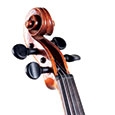There are many important skills involved in playing a string instrument, but the ability to tune one’s instrument well marks an essential milestone in a player’s development. Below are some suggestions that have worked well for me over the years in getting students to learn to tune better, in less time, and earlier in their string-playing careers.
Learn the Intervals
The first piece of advice for many students should be to learn precisely how a perfect fifth (or fourth, for string bass) sounds. Playing many of these intervals on fixed-pitch instruments like the piano is a good place to start. Students should also practicing singing them, both a capella and while playing them.
The Bow’s Importance
It is easy for students to underestimate the importance of the bow during tuning. If students are pressing too hard, moving too slowly, not applying the weight equally on the two strings, or changing direction too frequently, it can be much more difficult to determine what to do to get the strings in tune. Students should regularly practice playing open-string double stops with good tone and with equal volume on both strings. This is good for the bow hand apart from its value in tuning the instrument.
Adjust Pitch While Playing
Students should be able to adjust the pitch while bowing the strings. This can often be a challenge for cellists and bassists, but it is much more difficult to become good at tuning when there is a delay between hearing the pitch and making any adjustments. Cellists with pegs that cannot easily be moved with one hand can hold the instrument side saddle and reach over it with the left hand to get to the fine tuners. Bassists can often get their harmonics to ring for long enough to hear their pitch change as the tuners are adjusted. Otherwise, they can tune by playing open strings like the other string instruments instead of using harmonics.
Ear Training
Learning to hear the beats between mistuned consonances is another essential skill for players of variable-pitch instruments. Consider having them start with unisons. Find a pitch on one string that is the same as the next higher open string, such as D on the G string (or A string on the bass) played against the open D string. Then, while playing both strings, the student should practice moving the finger slightly above and below the pitch of the open string, carefully listening to the sound of the pitch discrepancy, and then the sound of the beats disappearing again as the finger is moved again to match that of the open string. Next, repeat this activity with an octave between the stopped pitch and the open string.
Apply this idea to fifths (or fourths). Starting with in-tune strings, alternate between sharpening the lower pitch and the upper pitch, in both cases by placing first finger just above the nut on that string. As the finger again gets removed, the student should carefully listen to how it sounds as the beats go away and the strings return to being in tune.
When It’s Too Close to Tell
When two pitches are only barely out of tune, it can be difficult to tell whether a string should be lowered or raised. When students cannot figure it out, they should pick a direction, and see if that makes it better or worse. Professional string players will move the pitch noticeably further away and then try again to get the strings perfect.
Learn to Tune Quickly
As important as it is to tune well, it is also essential that the process not take an excessive amount of time. Time is always valuable, and should never be wasted, plus music is a temporal art, so it is essential that tuning (whether of stopped or open pitches) takes place rapidly. In addition, neither audiences nor peers enjoy hearing extended tuning sessions.
Once speeding up of the tuning process is made a priority, it generally starts to occur. There are various ways to make a game out of it. The main thing to note is that such attempts will not tend to be successful until proficiency has been achieved in the previous exercises, in which time is not a factor.
Additional Considerations
Sometimes the adjustment of one string affects the bridge enough that it slightly alters the pitch of other strings. As a rule of thumb, recheck all other strings if any one string was changed by more than about 20 cents.
Different string brands sometimes have different enough timbres to give the impression that they are not quite right, even when they are perfectly in tune. If students are armed with this knowledge, they may stop fidgeting with the tuning of a pair of different strings.
Encourage students to recheck their strings frequently. They should also be encouraged to make quick adjustments unless the instrument is out of tune to the point the student cannot get it back in tune readily.
Conclusion
As with any skill, the more students do something, the better they tend to be at it. However, there has to be a fundamental willingness to change, or else any improvement will occur much more slowly. The suggestions above will help to get students tuning their instruments more accurately and quickly.
.jpg)






